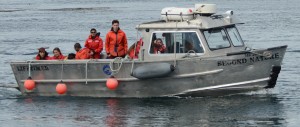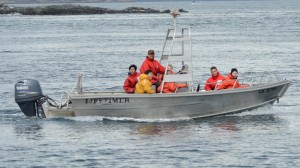The overcast morning sky cleared by noon, clouds pushed out by light northeast winds. In the afternoon, the wind turned to west and then in the evening to southwest. The barometer rose to 1013 hPA today. The forecast continues to call for rain along with variable winds at 5 – 15 knots.
There were only six whale watching visits observed in the Ecological Reserve today and no sports fishers. The large military explosions punctuating yesterday’s alternate sea lion swims and haul-outs continued today.
Today was census day at Race Rocks.
Steller Sea Lion 313
California Sea Lion 649
Harbour Seal 155
Northern Elephant Seal 14 (Two on Great Race -#5850 + female; 12 on Middle Rock)
Sea Otter 2
Southern Resident Killer Whale 16 (during count week)
Humpback Whale 3 (during count week)
Canada Goose 4 full time (2 adults 2 goslings) (flock of 25 chased off twice)
Harlequin Duck 1
Double-crested Cormorant 83
Pelagic Cormorant 9
Cormorants spp 18
Black Oystercatcher 6
Black Turnstone 12
Kildeer 2
Mew Gull 134
California Gull 11
Herring Gull
Glaucous-winged Gull total ( 277- adults; 74 – juveniles)
Ring-billed Gull 1
Gull spp 62
Song Sparrow 1
Savannah Sparrow 22
Fox Sparrow 1
Junco 3
Barn Swallows 2
American Pipet 1
A crew from operations at Pearson College, visited today and were very helpful in getting freshwater flowing again in the Eco-guardian’s House, amongst other things. Courtney was at the helm of Second Nature, Jeff brought all the plumbing gear and know-how to replace the pump and Jasper (PC Alumnus year 20) a curious, environmental engineer figured out a few of diesel pumping mysteries. A big shout out to all three. Thanks for the support.


